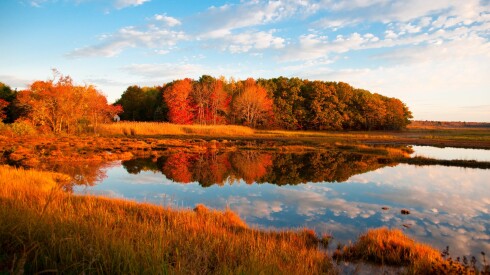We could all learn a thing or two from Europeans. Not just the way they dress, or how they make gourmet dining an effortless undertaking—but specifically how they celebrate the end of winter. With rituals that range from drowning effigies of the goddess of winter to throwing bread rolls from a hilltop, Europeans gleefully mark the occasion with true panache. In fact, they make Groundhog Day look like a snoozefest. To learn about the surprising ways they toast the return of sunshine and warmth across the pond, read on.
1. A witch gathering firewoodCounty Meath, Ireland
In between the solstice and equinox, there’s a Celtic holiday known as Imbolc, which has been celebrated in the United Kingdom for thousands of years. If you’re feeling particularly mystical this year, you might want to head to County Meath in Ireland (an hour from Dublin). Here, you’ll find a 5,000-year-old sacred burial complex known as Sliabh na Calliagh, or “The Hill of the Witch.” One of these cairns is perfectly aligned so that on the morning of Imbolc (which this year falls on February 1), a beam of sunlight penetrates the inner chamber and illuminates a white rock. According to some traditions, a witch will appear on the hillside to gather firewood—the more firewood she needs, the longer winter will drag on.
2. Colorful braceletsBulgaria (all over)
If you happen to be in Bulgaria on March 1, don’t be surprised if you’re gifted with a delicate red and white cotton bracelet. The spring ritual is based on a centuries-old pagan myth about an old woman named Baba Marta, or “Grandma March,” whose emotions were linked to the weather—hence, the month’s unpredictable sunny-then-stormy tendencies. In order to appease Baba Marta (and ensure a cloudless spring), locals tie a red-and-white strand around their loved one’s wrist. Then, when the first buds of spring appear, the bracelet is transferred to a tree, creating a whole countryside with festive, betassled branches.
3. Tossing bread, fire, and drinking live fishGeraardsbergen, Belgium
Does drinking a live fish out of a jeweled goblet sound like your idea of a party? Better book a trip to Belgium, stat. That’s how locals in the town of Geraardsbergen—and nowhere else in the world, as far as we know—get down on the last Sunday in February. To kick things off, participants (dressed as medieval knights, naturally) march to the top of Oudenberg Hill, where they proceed to toss thousands of krakelingen, or ring-shaped bread rolls, down on the town below. Later on, they set a wooden barrel on fire and carry torches back to the city, symbolizing the seasonal return of light. But not before they take turns drinking a live fish from chalices filled with red wine—even though everyone knows white pairs best with seafood.
4. Fire and an exploding snowmanZurich, Switzerland
When the calendar flips to April 16, residents of Zurich have only one thing on their mind: fire. That’s because here, the end of winter is celebrated with a 30-foot-tall pyre that’s crowned with a massive snowman, otherwise known as a Böögg. Similar to England’s Guy Fawkes celebrations, the pyre is lit in early evening, and as excitement builds, so do the flames. The climax comes when the head of the snowman—which is cunningly loaded with fireworks—explodes, sending the whole crowd into rapture (locals then grill sausages on the burning embers and keep the party going until late). According to tradition, the bigger the böögg’s boom, the sooner summer will come.
5. A boat full of 500 men in beastly costume (and, yes, fire)Mohács, Hungary
There are plenty of great photo ops at Hungary’s annual Busó Festival, which takes place near the southern border with Croatia. Spanning six days at the end of February, the festival hinges on the solemn arrival—by boat, along the Danube—of 500 men wearing wooden masks painted with demon faces and horns and dressed in shaggy animal hair cloaks. It’s by far one of the most dramatic ways to bid adieu to Old Man Winter, not to mention a highly creative one—locals spend months making sure their busó costumes are just right for the event. The holiday culminates in a massive bonfire in the center of town, with food vendors and music.
6. Burning and drowning the goddess of winterPrešov, Slovakia
If you’ve spent all winter cursing the ice-choked roads and skin-numbing cold, the town of Prešov, Slovakia, may have a way to take out that frustration. In Slavic tradition, the goddess of winter and death is personified as Mara—and to truly welcome spring, Mara has to burn. And then drown. So, every March, local schoolchildren join forces to make life-size versions of Mara (or Morena, as she’s known in certain dialects) out of wood and straw. Then, the scarecrowlike doll is ceremonially set on fire and tossed straight into the Torysa River, which eventually joins with the Danube and flows all the way into the Black Sea. Talk about catharsis.











